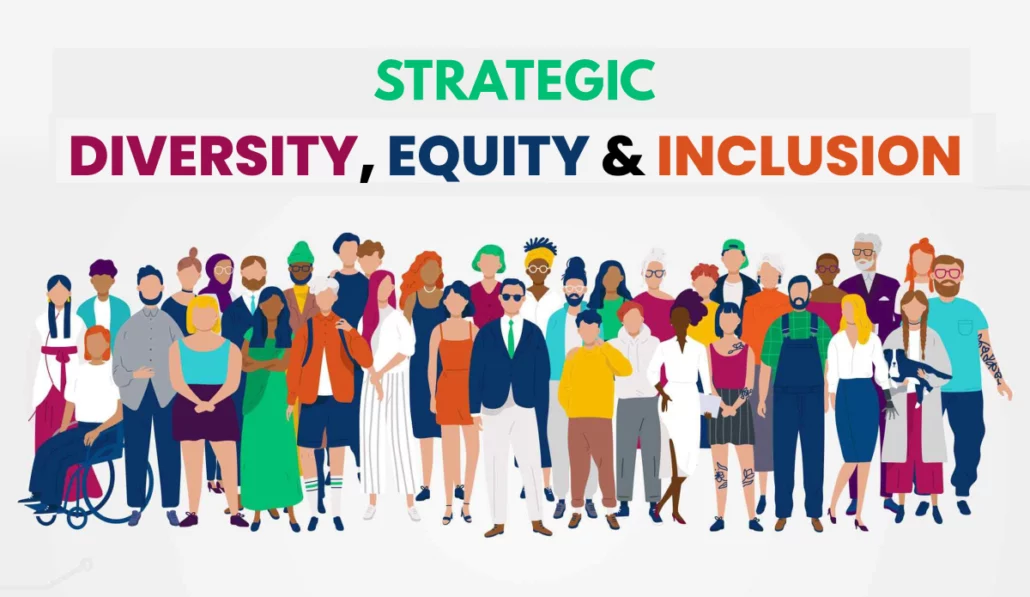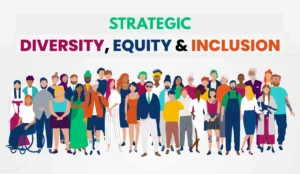Diversity, Equity, and Inclusion (DEI) has been an organizational development topic on the rise for the past few years, and for a good reason. Studies have shown that diverse leadership teams boost innovation(1), and financial performance (2), and companies that demonstrate a commitment to diversity are more likely to attract high-performing talent (3). The business case for implementing DEI initiatives is clear; however, I would also argue that there is a moral imperative to craft a formal DEI strategy for all companies.
DEI, or DEIB (Diversity, Equity, Inclusion, and Belonging), is about creating a more equitable and embracing workplace, where everyone has access to the same treatment, opportunities, and advancement. They can show up as themselves, with their beautiful mosaic of backgrounds, and not need to adapt and transform to fit into a unified culture. And where they feel included, feel a sense of belonging, and know that their perspectives are valued and meaningful– not regardless of their age, race, identity, sexual preference, ethnicity, disability, or range of neurodiversity– but because their distinctly unique blend creates one-of-a-kind ideas and contributions.
So, how does one go about creating a strategic Diversity, Equity, and Inclusion (DEI) management plan?
In order for a plan to be effective, it must align with the organization’s overall strategy, it must have an objective, and a strategy, and most of all– it must have accountability. The following components are what make up
Section 1: Assess the Current State
1. Determine why DEI is important to your company and what key business objectives you wish to achieve. What inspires you about DEI work? Is it to become a more attractive employer, to raise the bottom line, to create pay equity, to increase innovation and collaboration, to commit to a broader sense of corporate social responsibility– or perhaps a mix or a combination?
2. Assess your current level of employee diversity, equity, and inclusion. Conduct a DEI audit by utilizing an employee survey that does not just collect demographic information, but also includes questions about psychological safety, sense of belonging and purpose, and feelings of comfort and inclusion (for example: “do you feel that you have the same career growth opportunities as your peers?”).
Assessing the current state will allow you to meet your organization’s key business objectives, and identify what changes need to be made to how people work together– which brings us to section 2.
Section 2: Define Your Goals and Strategy
Having completed a DEI audit, you now have an understanding of the demographics of your organization. If your goals are to create a more diverse workforce, you can focus hiring efforts in countries that are under-represented, using job descriptions with gender-neutral language and clear-cut performance standards that can fairly evaluate new hires without bias, among many other strategies.
If you want to create pay equity, you can run a compensation analysis and then commit to equal pay for equal work and tie pay to job roles instead of employee location, while ensuring that employees are paid fairly to the market.
If your goal is to increase collaboration and innovation, you can implement cross-cultural mentorships, create safe spaces for sensitive topics and tough conversations, and train managers on recognizing subtle biases, handling microaggressions, and respecting multicultural differences and neurodivergent preferences or work styles.
Whatever your goal is, there are many strategies you can put in place. But– you must commit to actually taking action. Sadly, approximately 80% of companies(4) claim to hold Diversity and Inclusion as important to their organization, but fail to hold themselves accountable
Section 3: Make a Public Commitment to be Held Accountable
My favorite example of a company’s public commitment to DEI is Loom. Loom’s breakdown of age, disabilities, level of education, family status, gender, native language, race/ethnicity, sexual orientation, and veteran status in addition to publishing their commitments to Representation, Pay Equity, Growth & Mobility, and Community is a masterpiece of transparency and accountability.
By following the example of companies that choose to publish their commitment and their demographics data, you demonstrate to your team members (and prospective team members) that you are truly dedicated to providing an inclusive workspace– which increases employees’ sense of belonging, trust, loyalty, and pride in their organization.
Whatever your objective when it comes to your DEI strategies, public disclosure of your company’s actions and outcomes will not only support your organization but encourage and inspires others to do the same. By taking this step, you contribute to a more inclusive and equitable world for all. And that’s pretty darn remarkable.
Sources:
https://www.bcg.com/publications/2018/how-diverse-leadership-teams-boost-innovation
https://www.mckinsey.com/featured-insights/diversity-and-inclusion/diversity-wins-how-inclusion-matters
https://www.weforum.org/agenda/2019/04/business-case-for-diversity-in-the-workplace/
https://ssusa.s3.amazonaws.com/c/308463326/media/27436024f0b84dfd274918375735238/202102%20-%20DEI%20Report.pdf
https://www.mckinsey.com/featured-insights/diversity-and-inclusion/diversity-wins-how-inclusion-matters
https://www.weforum.org/agenda/2019/04/business-case-for-diversity-in-the-workplace/
https://ssusa.s3.amazonaws.com/c/308463326/media/27436024f0b84dfd274918375735238/202102%20-%20DEI%20Report.pdf





